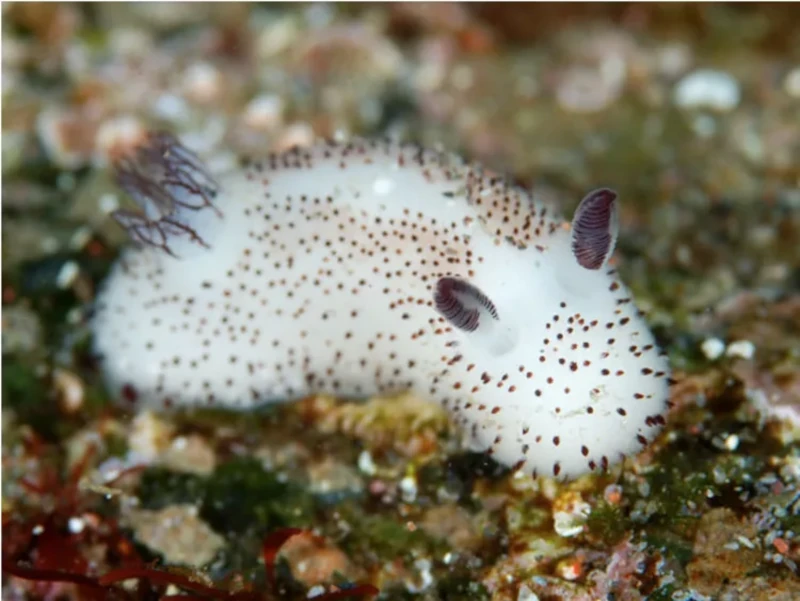
Sea Bunny Facts
- This creation of Nature and evolution most frequently goes by the flattering name of the Sea Bunny due to its appearance. For the moment, it has no other broadly accepted general title. Thoughly certainly not unknown, that’s somewhat uncommon.
- Within the scientific community, however, it’s typically referred to by its official moniker. Thankfully, though, that’s a comparatively simple term for the layperson to pronounce. That’s because the invertebrate holds the technical name of Jorunna parva.
- This marvelous creature received that appellation due to the efforts of Kikutaro Baba. This respected Japanese malacologist accomplished the first formal recognition of it as a separate and distinct species. That noteworthy event occurred in 1938.
- Presently, the remarkable Sea Bunny appears to be maintaining a population base that’s both stable and sufficient. That fortunate state also seems to hold true across its known range. Currently, the IUCN has no listing for it on the organization’s Red List.
- Nevertheless, the animal should be considered as facing at least some threats to its continued existence as a species. Many of these factors stem from the actions of mankind. They include such perils as habitat loss and the effects of climate change.
Related Articles
Sea Bunny Physical Description
The aptly-named Sea Bunny immediately captures the attention of most individuals fortunate enough to spot one. It does so, however, purely due to its distinctive appearance. That’s true since, in terms of pure physical size, it’s actually a small member of its Order.
Like all its many relatives, the marine marvel evolved as hermaphroditic in nature. The physiological characteristic of sexual dimorphism therefore does not apply in its case. As a result, all individuals of the amazing species display the same basic physical attributes.
The intriguing Gastropod often goes unobserved by those humans who venture into its environment. It blends into its background quite easily, partly due to its tiny size. In fact, an average total length for this fascinating species only equals approximately 0.4 in (1 cm).
What appears to be a fur coat covering the body of the Sea Bunny isn’t that at all. In actuality, it’s a dense gathering of small rods. Most experts believe these function as sensors. The colors of these vary, but include such shades as white, yellow, and rarely, green.
Yet it’s the two protuberances on its head that serve as the source of the common name. These present a combination of black and white in color. Though they create the appearance of rabbit-like ears, they’re actually more sensors. These aid in detecting scents in the water.
- Kingdom: Animalia
- Phylum: Mollusca
- Class: Gastropoda
- Order: Nudibranchia
- Family: Discodorididae
- Genus: Jorunna
- Species: J. parva
Sea Bunny Distribution, Habitat, and Ecology
The mesmerizing Sea Bunny inhabits a range that’s currently hard to pin down. The greater area in which it lives likely won’t surprise many who learn of it, however. That’s true because this marvelous creation of Nature inhabits the region known as the Indo-Pacific Ocean.
Within that larger zone, though, it’s only known from widely scattered concentrations. These include the waters near Japan, the Philippines, Seychelles, Reunion, and Papua New Guinea. It’s presently still unknown to science if it lives anywhere else in the world.
In all regions in which it’s known, the invertebrate displays remarkably versatile preferences for its choice of habitat. Populations have been spotted both in shallow regions and in significantly deeper regions. It principally resides wherever abundant food sources exist.
Astonishingly, its primary food consists of various species of sea sponge. While most of these are extremely toxic, it’s immune. Yet Nature makes use of these toxins in a resourceful manner. They become incorporated into its flesh, making it toxic to potential predators.
The Sea Bunny does augment its diet with smaller amounts of other food sources, though. This includes numerous varities of seagrass and algae. Intriguingly, it also consumes small animals on occasion, even including other types of small sea slugs and sea snails.
It’s truly a fabulous form of life. The same toxins it acquires from part of its food supply also explain its hues. Each prey species contains different chemicals. Its colors literally change depending on what it ate! Sadly, these wonders only live a few months to maybe one year.
Species Sharing Its Range
Check out our other articles on 4 Remarkable Reptiles of Australia, Maned Wolf, Southern Darwin’s Frog, Cheddar Gorge, Small Copper, Appalachian Avens, Striped Skunk, Gila Monster
